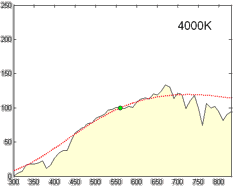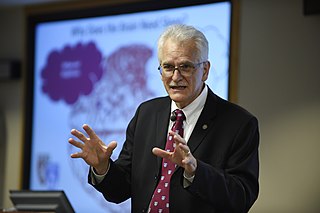
Light pollution is the presence of unwanted, inappropriate, or excessive artificial lighting. In a descriptive sense, the term light pollution refers to the effects of any poorly implemented lighting, during the day or night. Light pollution can be understood not only as a phenomenon resulting from a specific source or kind of pollution, but also as a contributor to the wider, collective impact of various sources of pollution.

Sleep is a state of reduced mental and physical activity in which consciousness is altered and sensory activity is inhibited to a certain extent. During sleep, there is a decrease in muscle activity, and interactions with the surrounding environment. While sleep differs from wakefulness in terms of the ability to react to stimuli, it still involves active brain patterns, making it more reactive than a coma or disorders of consciousness.

A circadian rhythm, or circadian cycle, is a natural oscillation that repeats roughly every 24 hours. Circadian rhythms can refer to any process that originates within an organism and responds to the environment. Circadian rhythms are regulated by a circadian clock whose primary function is to rhythmically co-ordinate biological processes so they occur at the correct time to maximise the fitness of an individual. Circadian rhythms have been widely observed in animals, plants, fungi and cyanobacteria and there is evidence that they evolved independently in each of these kingdoms of life.

Lighting or illumination is the deliberate use of light to achieve practical or aesthetic effects. Lighting includes the use of both artificial light sources like lamps and light fixtures, as well as natural illumination by capturing daylight. Daylighting is sometimes used as the main source of light during daytime in buildings. This can save energy in place of using artificial lighting, which represents a major component of energy consumption in buildings. Proper lighting can enhance task performance, improve the appearance of an area, or have positive psychological effects on occupants.

Light therapy, also called phototherapy or bright light therapy is the exposure to direct sunlight or artificial light at controlled wavelengths in order to treat a variety of medical disorders, including seasonal affective disorder (SAD), circadian rhythm sleep-wake disorders, cancers, and skin wound infections. Treating skin conditions such as neurodermatitis, psoriasis, acne vulgaris, and eczema with ultraviolet light is called ultraviolet light therapy.
Shift work is an employment practice designed to keep a service or production line operational at all times. The practice typically sees the day divided into shifts, set periods of time during which different groups of workers perform their duties. The term "shift work" includes both long-term night shifts and work schedules in which employees change or rotate shifts.

Full-spectrum light is light that covers the electromagnetic spectrum from infrared to near-ultraviolet, or all wavelengths that are useful to plant or animal life; in particular, sunlight is considered full spectrum, even though the solar spectral distribution reaching Earth changes with time of day, latitude, and atmospheric conditions.

High-energy visible light is short-wave light in the violet/blue band from 400 to 450 nm in the visible spectrum, which has a number of purported negative biological effects, namely on circadian rhythm and retinal health, which can lead to age-related macular degeneration. Increasingly, blue blocking filters are being designed into glasses to avoid blue light's purported negative effects. However, there is no good evidence that filtering blue light with spectacles has any effect on eye health, eye strain, sleep quality or vision quality.
Circadian rhythm sleep disorders (CRSD), also known as circadian rhythm sleep-wake disorders (CRSWD), are a family of sleep disorders which affect the timing of sleep. CRSDs arise from a persistent pattern of sleep/wake disturbances that can be caused either by dysfunction in one's biological clock system, or by misalignment between one's endogenous oscillator and externally imposed cues. As a result of this mismatch, those affected by circadian rhythm sleep disorders have a tendency to fall asleep at unconventional time points in the day. These occurrences often lead to recurring instances of disturbed rest, where individuals affected by the disorder are unable to go to sleep and awaken at "normal" times for work, school, and other social obligations. Delayed sleep phase disorder, advanced sleep phase disorder, non-24-hour sleep–wake disorder and irregular sleep–wake rhythm disorder represents the four main types of CRSD.
Dark therapy is the practice of keeping people in complete darkness for extended periods of time in an attempt to treat psychological conditions. The human body produces the melatonin hormone, which is responsible for supporting the circadian rhythms. Darkness seems to help keep these circadian rhythms stable.
Melatonin receptors are G protein-coupled receptors (GPCR) which bind melatonin. Three types of melatonin receptors have been cloned. The MT1 (or Mel1A or MTNR1A) and MT2 (or Mel1B or MTNR1B) receptor subtypes are present in humans and other mammals, while an additional melatonin receptor subtype MT3 (or Mel1C or MTNR1C) has been identified in amphibia and birds. The receptors are crucial in the signal cascade of melatonin. In the field of chronobiology, melatonin has been found to be a key player in the synchrony of biological clocks. Melatonin secretion by the pineal gland has circadian rhythmicity regulated by the suprachiasmatic nucleus (SCN) found in the brain. The SCN functions as the timing regulator for melatonin; melatonin then follows a feedback loop to decrease SCN neuronal firing. The receptors MT1 and MT2 control this process. Melatonin receptors are found throughout the body in places such as the brain, the retina of the eye, the cardiovascular system, the liver and gallbladder, the colon, the skin, the kidneys, and many others. In 2019, X-ray crystal and cryo-EM structures of MT1 and MT2 were reported.
Light effects on circadian rhythm are the effects that light has on circadian rhythm.
Designing lighting for the elderly requires special consideration and care from architects and lighting designers. As people age, they experience neurodegeneration in the retina and in the suprachiasmatic nucleus (SCN). Less light reaches the back of the eyes because the pupils decrease in size as you age, the lens inside your eye becomes thicker, and the lens scatters more light, causing objects and colors to appear less vivid. These symptoms are particularly common with persons having alzheimer's disease. Older people also have reduced levels of retinal illuminance, such as having smaller pupils and less transparent crystalline lenses. Furthermore, as an individual ages, they begins to lose retinal neurons, which not only compromises the ability to see but also to register a robust daily pattern of light-dark that is needed to maintain biological rhythms. The 24-hour light-dark cycle is the most important external stimulus for regulating the timing of the circadian cycle.

Charles Andrew Czeisler is a Hungarian-American physician and sleep and circadian researcher. He is a leading researcher and author in the fields of the effects of light on human physiology, circadian rhythms and sleep medicine.

Ecological light pollution is the effect of artificial light on individual organisms and on the structure of ecosystems as a whole.
Studies, which include laboratory investigations and field evaluations of population groups that are analogous to astronauts, provide compelling evidence that working long shifts for extended periods of time contributes to sleep deprivation and can cause performance decrements, health problems, and other detrimental consequences, including accidents, that can affect both the worker and others.
Dr. Debra J. Skene is a chronobiologist with specific interest in the mammalian circadian rhythm and the consequences of disturbing the circadian system. She is also interested in finding their potential treatments for people who suffer from circadian misalignment. Skene and her team of researchers tackle these questions using animal models, clinical trials, and most recently, liquid chromatography-mass spectrometry. Most notably, Skene is credited for her evidence of a novel photopigment in humans, later discovered to be melanopsin. She was also involved in discovering links between human PER3 genotype and an extremely shifted sleep schedules categorized as extreme diurnal preference. Skene received her Bachelor of Pharmacy, Master of Science, and Ph.D. in South Africa.
Francine Laden is an American epidemiologist who is Professor of Environmental Epidemiology at the Harvard T.H. Chan School of Public Health. Her research has investigated the environmental epidemiology of chronic disease. She serves as co-director of the Harvard University and Boston University center for research on environmental and social stressors in housing across the life course. Laden has also served on the United States Environmental Protection Agency advisory board.
Elizabeth Klerman is a professor of neurology at Harvard Medical School. Her research focuses on applying circadian and sleep research principles to human physiology and pathophysiology. She also uses mathematical analysis and modeling to study human circadian, sleep, and objective neurobehavioral performance and subjective (self-reported) mood and alertness rhythms.
Chronodisruption is a concept in the field of circadian biology that refers to the disturbance or alteration of the body's natural biological rhythms, particularly the sleep-wake cycle, due to various environmental factors. The human body is synchronized to a 24-hour light-dark cycle, which is essential for maintaining optimal health and well-being. However, modern lifestyles, which involve exposure to artificial light, irregular sleep schedules, and shift work, can disrupt this natural rhythm, leading to a range of adverse physiological outcomes. Chronodisruption has been linked to a variety of health issues, including neurodegenerative diseases, diabetes, mood disorders, and cancer. Such disruptors can lead to dysregulation of hormones and neurotransmitters, though research continues to fully understand the physiological implications of chronodisruption. Indeed, research in chronobiology is rapidly advancing, with an increasing focus on understanding the underlying mechanisms of chronodisruption and developing strategies to prevent or mitigate its adverse effects. This includes the development of pharmacological interventions, as well as lifestyle modifications such as optimizing one's sleeping environment and timing of meals and physical activity.









